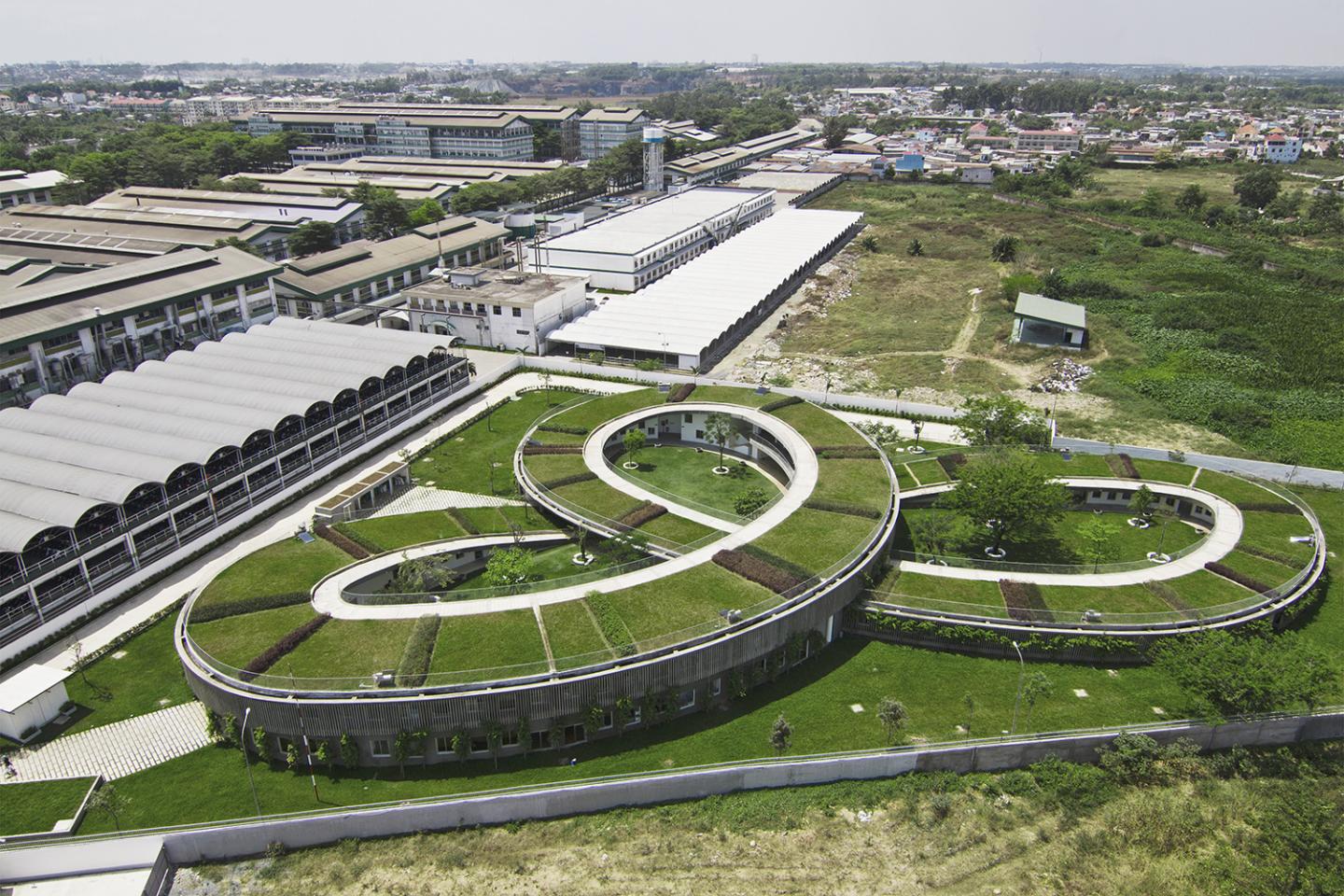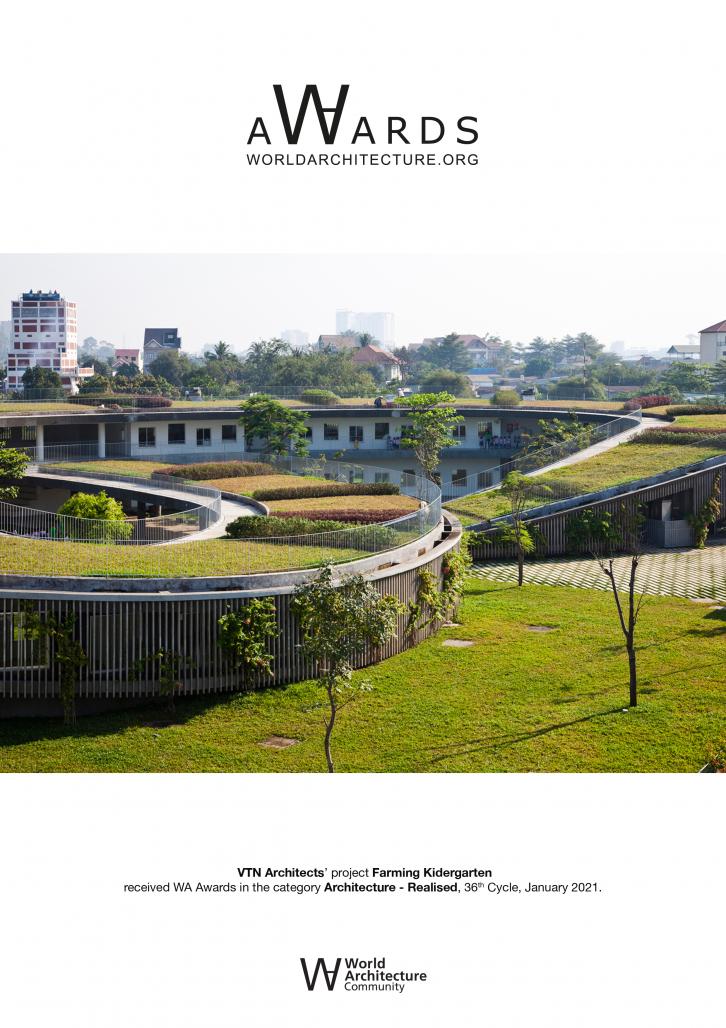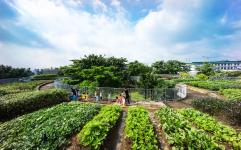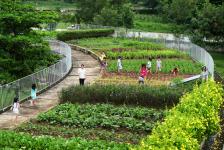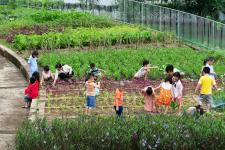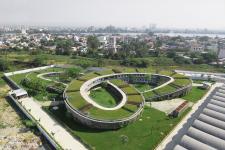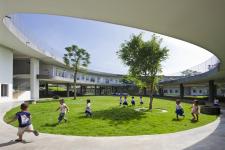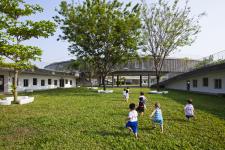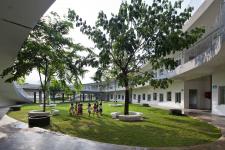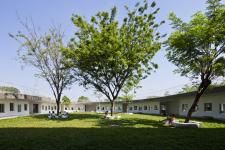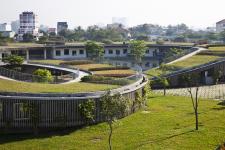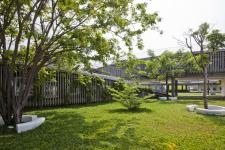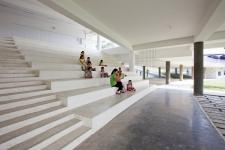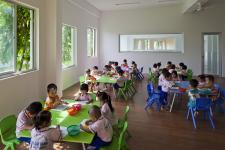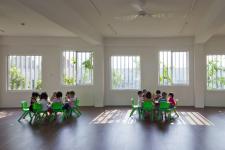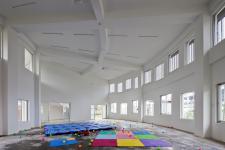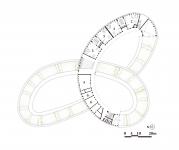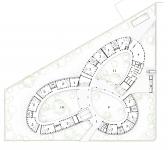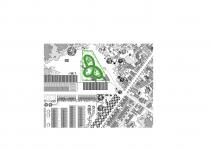1) Introduction
Vietnam has many productive lands for agriculture, for example the Mekong Delta. However, recently there have been many problems which have taken their toll on nature and agriculture, such as floods, salt damage and droughts.
There are serious urban issues, too. Air pollution is a huge concern, with Vietnam ranking highly for its poor quality air. This is mainly due to factories and the constantly visible abundance of motorbikes in every city throughout the land. Cities in Vietnam are also losing their greenery. Consequently, there are no safe playgrounds for children to play and they are becoming inactive.
Against the backdrop of these issues, we propose Farming Kindergarten, a place to provide safe food, to enhance green community, and to teach children the importance of agriculture and relationship with nature.
2) Climate change and food crises
There are more than 7 billion people currently living on our planet and this number is increasing every day. Population growth and development are massive problems for Asian countries which are located in tropical climates. These countries are exempt from the urban and architectural discoveries that are used in temperate climate countries and therefore this brings a new set of challenges.
Vietnam is not the exception to this situation and is experiencing numerous problems caused by population growth and recent climate change. It is expected that 40% of the Mekong Delta, one of the biggest rice-producing regions in the world, will be flooded if the Earth’s sea level rises by one meter. Floods occur frequently, not only in rural areas but also in urban areas like Ho Chi Minh City. Natural disasters such as typhoons, salt infiltration and drought are getting more intense. 45% of farming land in Mekong Delta was affected by salt water in 2005, while 620,000 hectares land was damaged by drought in 2010, according to the researches by Mekong River Commission in Vietnam and Food and Agriculture Organization. All these problems are related to environmental destruction but can result in food crises.
3) Urban issues and inactive children
The population of Vietnam is currently 87 million and rapidly increasing, it has been forecast to reach more than 100 million by 2020s. Aside from a huge increase in population, Vietnam also faces a large number of urban problems, such as, traffic. In Ho Chi Minh City, the most populated city in Vietnam, more than 4,200,000 motorbikes are owned by 7,800,000 citizens. An abundance of motorbikes causes daily traffic congestion as well as serious air pollution. According to statistics by World Health Organization in 2007, more than 16,000 people died of diseases related to air pollution in the city. This so called development kills citizens, and similar situations are found all across the country.
Another prominent urban issue is a lack of green. Because of its urbanization, Vietnamese cities have lost their greenery. In Ho Chi Minh City, as one example, park, garden and green stripe areas are only 535 hectares in total, this means that only 0.25% area is covered by green in the entire city. Cities in Vietnam have gone too far away from their beginnings as a rampant tropical forest. As a result, new generation in urban areas is losing its connection with nature.
Due to these urban issues, there are no safe playgrounds for children to play. Consequently, they are becoming inactive. Many children nowadays stay in their house - reading comics, watching TV and playing video games - instead of playing outdoors. According to a new study in the British medical journal, "The Lancet", 80 to 90 percent of teens in developed east Asian countries are near-sighted. Sooner or later, Vietnamese children will confront with the same problem. Without improving the urban situation now, future generation will be so inactive that they stay all the day in conditioned rooms in a concrete jungle, and they will bleed the Earth dry of all of its natural resources. Education to grow the environmental consciousness is the most essential and urgent subject to sustain future development, in this sense.
4) The concept of Farming Kindergarten
Against the backdrop of food crises and inactive children caused by urban issues, we propose a kindergarten with green solutions. One case-study building was designed in Dongnai, a satellite city of Ho Chi Minh City, in Vietnam.
In developing cities with increasing population, more and more places for nursing as well as public education facilities are being required. Therefore, re-designing of building typologies such as a kindergarten has a great impact to the society. It can be a model for other typologies to follow. Besides, experience in early childhood is a deciding factor for human development. Thus, if we succeed to change kindergartens, then the mindset of future generation successively changes. A kindergarten should be an architecture to make environmentally friendly people - green man and woman.
The building concept is a "Farming Kindergarten" with a continuous green roof, providing food and agriculture experience to Vietnamese children, as well as a safe outdoor playground. The green roof is a triple-ring-shape drawn with a single stroke, creating three courtyards inside. While these internal courtyards provide safety and comfortable playgrounds for children, the roof makes landing to the courtyards at both sides, allowing children to enter a very special eco-friendly experience when they walk up and go through it. This green roof is designed as a continuous vegetable garden, a place to teach children the importance of agriculture and relationship with nature. The building is covered by vertical louvers made of pre-cast concrete, which is utilized as "vertical garden" for creepers such as bitter gourd and cucumber.
5) Management organization of Farming Kindergarten
Educators are composed not only of teachers, but also of parents and volunteers from neighborhood. It is important to involve parents and volunteers, in order to lighten the work load of management team of kindergarten. Besides, in doing so, not only children but also adults can grow their environmental consciousness. Almost all adults currently living in the city were originally farmers. Therefore, they have knowledge and experience of agriculture to convey to the next generation.
A kid educated in Farming Kindergarten will become a "green man". In the future, they will convey their experience to the next generation, so that the tradition and knowledge of agriculture will go on.
6) Food distribution from Farming Kindergarten
Farming Kindergarten, of course, produce not only "green man" but also vegetables. The harvest from Farming Kindergarten will be distributed to the families of children, helping out with rather small family budget of Vietnamese workers (average income of Vietnamese workers is just 180USD per a month).
Nowadays, food safety is one of the biggest concern of the people in Vietnam. Problem is that many vegetables were polluted by unhealthy agricultural chemicals and preservative. The vegetables from Farming Kindergarten is healthy and secure, because it is taken care of consumer themselves.
7) Natural water cycle of Farming Kindergarten
Vietnam is a country of high rainfall. So it is essential to use rainwater to grow plants in Farming Kindergarten. Rainfall is collected by the wide gutter, which is covered by pre-cast concrete panels and utilized as a access pathway to the vegetable gardens on the roof. The water of gutter drop into courtyards through gargoyles. The courtyards are gently sloping toward their center, therefore all rainwater fallen to Farming Kindergarten are collected eventually in water tanks buried under the center of the courtyards. The water are, then, pumped up to the green roof in sunny day, by using the energy produced by photovoltaic modules. On rainy days, rainfall directly brings water to the roof garden, while on sunny days, power of sunshine pumps up the stored water to it. Therefore, the vegetable garden of Farming Kindergarten are irrigated by natural energy and resources all the time.
8) Fluidity of activities
In order to grow the environmental consciousness of children, it is essential to make the gardens familiar to them. So the roof is designed as a three dimensional strip with gentle slope, connected to the courtyards - the main playground for children - at both ends. Thanks to the from of this roof, The fluidity of activities is achieved, which naturally lead children to the vegetable garden roof.
All functions of the kindergarten are under the green roof, such as classrooms, a gymnasium and administration office rooms. The sloping roof creates an ideal section for the gymnasium due to its high ceiling.
All the rooms are connected with a single stroke circulation along the courtyards. Some volumes under the roof are eliminated to create pilotis spaces, which connect the courtyards and surrounding landscape of the building moderately. Besides, thanks to these pilotis spaces as well as the narrow strip-shaped building volume with openings on both sides, the wind flow into the building throughout.
9) Vegetable gardens as major elements of the passive design strategy
The green roof and vertical garden of louvers are also profitable to improve the internal environment of the building. The green roof will work as insulation and cool the building's surface by transpiration effect. The external vertical block out solar rays. These shading devices also enhance health and comfort whilst reducing energy use from artificial lighting. The louvers reduce glare and ensure that harsh daylight is filtered in the classrooms.
Thanks to these passive design methods, the kindergarten can be operated without having installed air conditioners in the classrooms despite being located in a harsh tropical climate. Air conditioning can be minimally installed in administration spaces, reducing energy consumption greatly.
10) Construction and material
Farming Kindergarten is a prototype of public school typology. Therefore, two top priorities of construction method and material selection are cost-efficiency and workability, so that it could be used as an example for future kindergarten projects in Vietnam. Accordingly, the combination of local materials and low-tech solutions locally available are applied to its construction, which is also profitable to minimize the carbon footprint and the environmental impact of the construction, as well as to promote the local industry.
The structure of Farming Kindergarten is composed of reinforced concrete frame with brick wall, which is the most typical construction method in Vietnam without using special technology, nor skilled workers. Thanks to this simple rigid frame with economical span, the construction cost per one square meter is expected to be only 350 USD including finishes, which is competitively cheap even within the Vietnamese market.
A Farming Kindergarten, for 500 pre-school children, was designed and is being constructed in Dongnai, a newly developing city near Ho Chi Minh City, Vietnam. The site is located next to the big factory, and the building will be devoted for the children of factory workers. The building form is adjusted to fit into the triangle plot.
In this model case, recycled water from factory is utilized for irrigation instead of rainwater recycle system. Except for this, all the ideas and components of Farming Kindergarten will be experimented here. It is planned to utilize a part of roof as a vegetable garden, and when this experimental garden is successful, whole roof will be covered by various vegetables.
Architectural and mechanical energy-saving methods are comprehensively applied including but not limited to vegetable garden roof and vertical louvers, ex. recycle materials, solar water heating and so on. These devices are designed visibly for children to play their important role in sustainable education.
2011
2013
Project name: Farming Kindergarten
Status: Built in 10.2013
Program: Kindergarten
Location: Dongnai, Vietnam
Site area: 10,650 m2
GFA: 3,800m2
1F; 2615.9m2
2F; 1113.6m2
Contractor: Wind and Water House JSC
Client: Pou Chen Vietnam
Photographs: Hiroyuki Oki
CFD analysis: Environment Simulation Inc.
Architect Firm: Vo Trong Nghia Architects
Principal architects: Vo Trong Nghia, Takashi Niwa, Masaaki Iwamoto
Architects: Tran Thi Hang, Kuniko Onishi
Farming Kindergarten by VTN Architects (Vo Trong Nghia Architects) in Vietnam won the WA Award Cycle 36. Please find below the WA Award poster for this project.

Downloaded 124 times.
